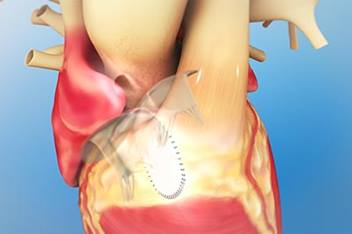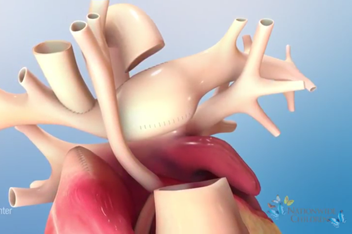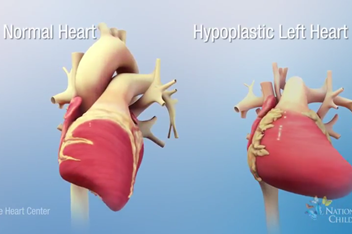Animation Library
The Heart Center has created a number of educational animations to help our patients understand their heart conditions and the procedures we perform to treat them.
The Heart Center has created a number of educational animations to help our patients understand their heart conditions and the procedures we perform to treat them.

An atrial septal defect is an abnormally large hole between the upper chambers of the heart that remains after birth, which can lead to enlargement of the heart, abnormal heart rhythm and damage blood vessels in the lungs. Depending on the size of the hole, a catheter or surgical procedure may be recommended to repair the hole with a device or a patch.

One of the conditions The Heart Center supports is called an Atrioventricular (AV) Septal Defect. An AV Septal Defect is a birth defect of the valves separating the hearts upper and lower chamber and the walls between the chambers. Atrioventricular (AV) Septal Defect animations and models were developed by The Heart Center at Nationwide Children's Hospital to give families a better understanding of your child's diagnosis and potential treatment options.

If your baby's heart has an Atrioventricular or AV Septal Defect, your child's doctor may recommend a procedure to repair it. The goals of an AV Septal Defect repair are to close the hole between the chambers of your child's heart and repair the valves. AV Septal Defect animations and models were developed by The Heart Center at Nationwide Children's Hospital to give families a better understanding of your child's diagnosis and potential treatment options.

Hypoplastic left heart syndrome is a condition in which one lower chamber of the heart is either underdeveloped, too small or missing a valve. The first surgery for treating hypoplastic left heart syndrome happens a few days after birth and improves the ability blood flow to the baby’s body.

Hypoplastic left heart syndrome is a condition in which one lower chamber of the heart is either underdeveloped, too small or missing a valve. The Stage II procedure is usually performed four to six months after stage I. It decreases the amount of blood the right ventricle has to pump while creating improved blood flow from the upper body to the lungs.

The Fontan procedure is the third and final surgery to treat hypoplastic left heart syndrome, and usually happens between two and five years of age. This procedure improves blood flow from the lower body to the lungs, which further decreases the workload of the single ventricle and improves oxygen levels.

Hypoplastic left heart syndrome is a condition in which one lower chamber of the heart is either underdeveloped, too small or missing a valve. This video shows the difference in anatomy between a hypoplastic left heart and a normal heart.

If your baby has a heart problem called the Patent Ductus Arteriosus (PDA), your child's doctor may recommend a procedure to fix it called a Patent Ductus Arteriosus Occulusion.

Tetralogy of Fallot is a heart defect made up of four different heart problems: ventricular septal defect, overriding aorta, pulmonary stenosis and right ventricular hypertrophy. These problems result in cyanotic, or blue, skin on babies because of a lack of oxygen.